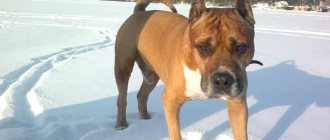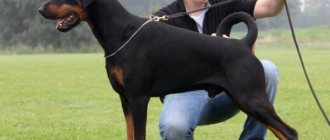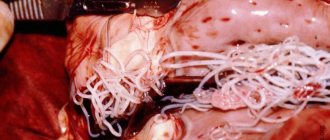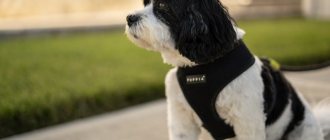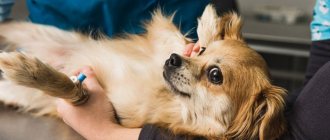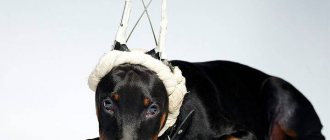The cosmetic procedure of tail docking is now considered blasphemous. Amputation is carried out only to maintain acceptable conformation for exhibitions and breed competitions. But, according to the European Convention for the Protection of Pet Animals, judges are obliged to accept and evaluate equally competitors with a natural tail shape and a docked one.
Read a useful article on the topic: “What is ear cropping in dogs: features and necessity of the procedure.”
Functional load
But here's what zoologists pay attention to:
First of all, the tail has a communicative function. This is a means of communication with other animals, and since the dog lives with a person, it also lives with him. The second point is that the tail can serve as an assistant when moving. Beauty. Yes, in the animal world this fact is also of great importance.
During the mating season, males use it to attract the attention of females. Finally, it is simply an extension of the spine. Would you like to have several vertebrae removed?
It is already becoming clear why a dog needs a tail. Now let's look at why a person decided to deprive a pet of a legal organ.
History of the procedure
You can’t even imagine how deeply the cupping procedure goes back to ancient times. On ancient Egyptian frescoes you can find an image of a black dog with cropped ears. She personifies the god of the dead, Anubis.
In 450 BC, the first documented case of docking a dog occurred in Ancient Greece. Alcibiades cut off the tail of his dog, which caused a violent reaction from the Athenians.
Lucius Columella wrote that ancient Roman shepherds cut the tails of dogs on the fortieth day of birth to avoid rabies. The ancient Greek traveler Pylos also noticed the docking of Roman dogs.
In 1763, in the German city of Weimar, a decree was issued on the imposition of taxes on peasant dogs. Boyar dogs were docked to distinguish them from peasant dogs.
In the 17th century, in England, all dogs except guard dogs were subject to taxes. To present their dog as a guard dog, people docked their tails.
How does this happen
The procedure is simple and no special preparation is required. It does not last long and consists of several stages:
- a painkiller is administered, calculated according to the dog’s weight;
- the skin on the tail is moved as close as possible to its base. This is done necessarily, because after circumcision the skin will move into place and close the wound. If there is not enough skin, the stump will take a long time to heal, and hair will not grow at the end of the tail in the future;
- A bandage tourniquet is applied at the base to reduce bleeding;
- circumcision is carried out with scissors or a scalpel;
- the wound is treated with an antiseptic;
- the tourniquet is removed so that the skin moves into place, and then the tourniquet is tied again;
- for puppies after 10 days, a suture is placed at the end of the docked tail; younger puppies do not need to do this, the wound quickly heals on its own;
- the tourniquet is removed.
It is important to ensure that the mother does not lick the tails of her puppies for some time after the operation. The threads are removed from the seam after 4-5 days, sometimes earlier
The threads are removed from the seam after 4-5 days, sometimes earlier.
Preparation
And yet, if you are determined to remove your pet’s tail, you need to remember a number of absolute requirements that are observed during this procedure. First of all, keep in mind that docking in puppies is carried out 3-5 days after birth, when the newly born pet still does not really feel or remember pain. The tail vertebrae at this age have not yet formed, representing cartilaginous formations. In addition, at this age, wounds tend to heal quickly. It should be noted that the larger the dog, the earlier the procedure should be performed; large breeds are recommended to undergo surgery even at two days of age. If it was not possible to dock the tail within a few days immediately after the birth of the puppy, then the procedure can be performed later, but then general anesthesia will be required, and after amputation it will be necessary to apply stitches.
Cost and where they make it
Operations are carried out both at home and in specialized veterinary clinics. In Russia, you can dock a puppy’s tail within 500 rubles. But ear cropping, due to the complexity of the procedure, will cost more - in the amount of 2-4 thousand rubles.
In some countries, docking dogs is prohibited. These countries include: Austria, Belgium, Great Britain, Germany, Greece, Denmark, Ireland, Iceland, Spain, Italy, Latvia, Lithuania, Luxembourg, the Netherlands, Norway, Poland, Portugal, Slovenia, Ukraine, Finland, Czech Republic, Switzerland, Sweden , Estonia.
That is, in all EU countries, docking of dogs is unacceptable and is carried out only at home. In the US and some other countries, docking is still acceptable.
Possible complications after surgery
Even if the operation was performed under anesthesia, the pain will not go away. Babies will squeak and cry. Some owners even complain that the puppy has lost his voice after docking his tail. This can happen if the dog has damaged ligaments from screaming.
Another problem is the occurrence of suppuration. If the amputation was carried out with non-sterile instruments or an antiseptic was not used to treat the sutures, then inflammation cannot be avoided. Difficult healing is also observed with active licking of wounds. The mother will instinctively treat the puppies, which should not be allowed.
With prolonged healing, scars can form, spoiling the appearance of the ponytail.
Scientists have proven the negative impact of tail docking on the general condition of the dog’s nervous system and sensitivity:
- Removing the tail vertebrae can impair a dog's motor skills;
- Due to the removal of the “counterweight,” the load on the pelvic region and hind limbs is incorrectly distributed, which leads to deformation of the paws and muscle atrophy;
- Dogs with docked tails are more likely to develop intervertebral hernias;
- Due to the operation, dogs may suffer from diseases of the urinary system;
- The absence of a tail in a dog is like the absence of a tongue in a person; relatives are less likely to come into contact with such a pet, because a bob-tailed dog is more difficult to understand;
- Statistically, pets with docked tails are more aggressive.
Experiments on rats have proven that overall sensitivity in animals with amputated tails is reduced.
Is it possible to dock the tail of an adult dog?
The main problem when operating on adult dogs is complications after anesthesia. Not all animals over 2 years of age respond positively to anesthesia. The heart is especially defenseless against the action of anesthetic vapors.
Any dog owner will say that “the game is not worth the candle.” Because of a simple whim, a person can lose a pet. Although veterinarians take on work of any complexity, issuing large checks for the procedure. In any case, it is better not to take risks and leave the pet’s tail in its natural form.
How to place the ears?
Some breeders believe that after cropping the ears stand up on their own - this is a common misconception. In order for the ears to stand up correctly, they must be glued, following the recommendations of the breeder or supervising veterinarian.
A common reason that the ears do not stand up is creases, so before gluing you need to make sure that they really are there. To determine them, you need to squeeze the base of the auricle and palpate the entire surface as carefully as possible, slowly moving from the base upward.
If during the examination you find a small strip of tissue, it should be clamped on both sides; if at this moment the ear takes a vertical position, the cause of the problem has been found.
The mechanism for correcting the situation depends on the location of the problem area. If the upper area is affected, then the situation will be corrected by taking special vitamins; if the scar tissue is located at the base or in the middle of the auricle, you need gluing. It is usually carried out using massive structures. It is advisable to carry out all manipulations under the supervision of an experienced veterinarian, since if the frame is installed incorrectly, at best, you risk getting a setup that does not meet breed standards, and at worst, a violation of the pet’s blood circulation.
In recent years, a special adhesive-fixer has become very popular, which, during the drying process, holds the ear in the chosen position, without requiring the use of additional materials.
At what age is it best to have surgery?
The best age for cupping is 3-10 days after birth. It is believed that during this period puppies are less sensitive to pain, and the cartilaginous joint tissues have not had time to ossify. Therefore, children are operated on without anesthesia, without applying a tourniquet. The main rule is healing without licking the mother; the breeder must monitor this.
Amputation is often performed at the age of 10-20 days . Then local or general anesthesia is required. The dog is placed on its stomach, its paws and muzzle are fixed, and part of the tail is removed. If a dog is operated on at 3-4 weeks, then a tourniquet must be applied to the tail.
Evidence from experts suggests that puppies have an increased sensitivity to pain and the “humaneness” of tail trimming in childhood is not confirmed by anything. During amputation, the integrity of muscles, tendons, bone and cartilage joints is disrupted. In this case, more than 14 sensory nerves are affected.
Before the operation, laboratory tests are carried out: blood tests, ultrasound, and less often, x-rays. This is necessary to exclude contraindications to drugs and anesthesia components. Before the procedure, it is recommended to prepare your pet:
- Cleanse from helminths within 2 weeks;
- Do not feed your pet for 12 hours, but increase the drinking regime;
- Every hour before surgery, measure the temperature (maximum - 39 degrees, minimum - 37);
- Select the amputation site (the breed standard will help with this), shave the tail in the selected area, and disinfect it with an aqueous antiseptic (Chlorhexidine).
A categorical contraindication is congenital physiological abnormalities in the puppy. The procedure is not performed on lethargic, sick pets with unusual or inflamed discharge.
How does this happen
The procedure is simple and no special preparation is required. It does not last long and consists of several stages:
- a painkiller is administered, calculated according to the dog’s weight;
- the skin on the tail is moved as close as possible to its base. This is done necessarily, because after circumcision the skin will move into place and close the wound. If there is not enough skin, the stump will take a long time to heal, and hair will not grow at the end of the tail in the future;
- A bandage tourniquet is applied at the base to reduce bleeding;
- circumcision is carried out with scissors or a scalpel;
- the wound is treated with an antiseptic;
- the tourniquet is removed so that the skin moves into place, and then the tourniquet is tied again;
- for puppies after 10 days, a suture is placed at the end of the docked tail; younger puppies do not need to do this, the wound quickly heals on its own;
- the tourniquet is removed.
It is important to ensure that the mother does not lick the tails of her puppies for some time after the operation. The threads are removed from the seam after 4-5 days, sometimes earlier
The threads are removed from the seam after 4-5 days, sometimes earlier.
What is it for
The first reason the Ancient Romans docked dogs' tails was for safety. The smaller the body area of a fighting dog, the more difficult it is to inflict wounds during a fight. So not only the tails of the gladiator dogs were cut, but also the ears.
Peasants in the Middle Ages performed docking on herding dogs. People believed that this procedure would protect against rabies. A little later, in the 18th century, in England, bushy tails were cut for shepherd dogs guarding herds. The shepherds believed that this would make it easier for the dogs to fight the wolves. In addition, they did not want to deal with hygiene procedures, pulling out garbage and branches from the wool.
Hunting dogs had their tails cut off to prevent them from clinging to trees and bushes while chasing wild animals. The procedure was especially useful for burrow hunters who encountered a predator underground in complete darkness.
But it wasn’t just the reasons for preserving the pet’s health that worried the breeders. Since the 18th century, there was a law in Europe according to which a tax was charged for any purebred non-working dog. A docked tail was a sign that the dog belonged to a police or security unit.
Now almost all of Europe has banned the amputation of tails for cosmetic purposes. The law allows circumcision only for service dogs that are registered with police, border, and rescue services.
In the CIS countries the situation is different; docking is still considered legal if required by the breed standard. The final decision still remains with the owner.


